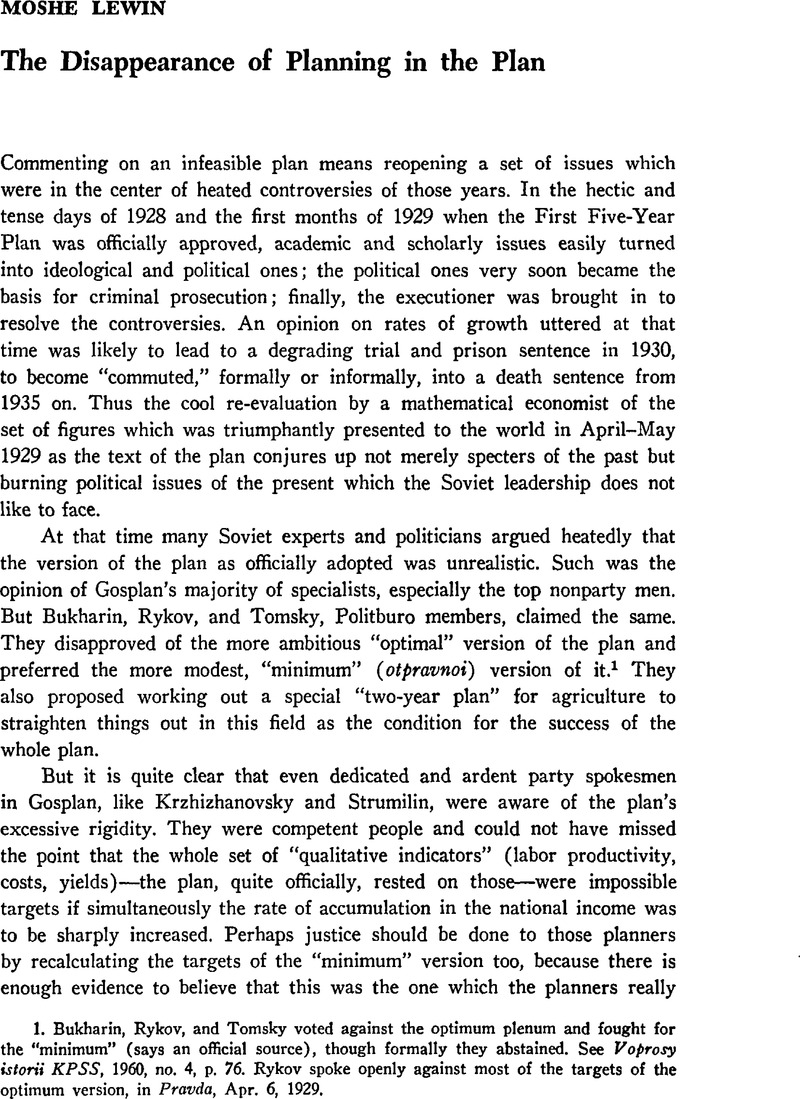Article contents
The Disappearance of Planning in the Plan
Published online by Cambridge University Press: 27 January 2017
Abstract

- Type
- Discussion
- Information
- Copyright
- Copyright © Association for Slavic, East European, and Eurasian Studies. 1973
References
1. Bukharin, Rykov, and Tomsky voted against the optimum plenum and fought for the “minimum” (says an official source), though formally they abstained. See Voprosy istorii KPSS, 1960, no. 4, p. 76. Rykov spoke openly against most of the targets of the optimum version, in Pravda, Apr. 6, 1929.
2. Grin'ko, G. F., “Plan velikikh rabot,” Planovoe khoziaistvo, 1929, no. 2, pp. 9–10.Google Scholar
3. Quoted from Gosplan Archives in I. Gladkov, Planovoe khoziaistvo, 1935, no. 4, p. 136.
4. See the studies by Naum, Jasny, Soviet Industrialisation, 1928-1952 (Chicago, 1961)Google Scholar, Zaleski, Eugène, Planification de la croissance et fluctuations économiques en U.R.S.S.., vol. 1 : 1918-1932 (Paris, 1962)Google Scholar, and Alexander Erlich, “Development Strategy and Planning : The Soviet Experience,” in Millikan, Max F., ed., National Economic Planning (New York : National Bureau of Economic Research, 1967)Google Scholar.
5. S. G. Strumilin, in Planovoe khoziaistvo, 1929, no. 1, p. 109.
6. Kuibysheva, G. V. et al., V. V. Kuibyshev : Biografiia (Moscow, 1966).Google Scholar
7. For the trouble Ordzhonikidze kept creating for Kuibyshev see Ikonnikov, S. N., Sozdanie i deiatel'nosf ob″edinennykh organov TsKK-RKI v 1923-1934 gg. (Moscow, 1971), p. 344 Google Scholar; and about more trouble, after Ordzhonikidze attacked VSNKh during the Sixteenth Congress, see Kuibysheva et al., V. V. Kuibyshev, pp. 299-300.
8. Kuz'min, V. I., Istoricheskii opyt sovetskoi industrialisatsii (Moscow, 1969), pp. 71–72.Google Scholar
9. Talking about five-year plans in agriculture now is a “useless affair,” said Molotov, Bol'shevik, 1929, no. 22, p. 22.
10. V. A. Levin, Planovoe khosiaistvo, 1930, no. 2, p. 32.
11. Bol'shevik, 1931, no. 3, p. 24.
12. Pervushin, S. P., in Venzher, V. G. et al., Proisvodstvo, nakoplenie, potreblenie (Moscow, 1965), p. 20.Google Scholar
13. For Preobrazhensky's forecast of a nearing crisis similar to the one of autumn 1923 see Bol'shevik, 1927, no. 6, p. 61, written in March 1927. But he had been analyzing and anticipating this kind of difficulty in exchanges with the peasants since his “Economic Notes,” Pravda, Dec. 5, 1925.
14. Trotsky recommended “an offensive” in “What Now?” (July 12, 1928), Third International After Lenin (New York, 1957); but he advised his followers in August 1928 that he did not mean at all the same thing that Stalin was doing. This is discussed in Isaac, Deutscher, The Prophet Unarmed (London and New York, 1959), p. 447.Google Scholar
15. The figures are from Narodnoe khoziaistvo SSSR v 1970 g. (Moscow, 1971), p. 131; Gorbunov, E. P., Sotsialisticheskaia industrializatsiia SSSR i ee burzhuaznye kritiki (Moscow, 1962), p. 37 Google Scholar, and S. P. Pervushin, in Venzher, Proizvodstvo, nakoplenie, potreblenie, p. 20.
16. Quoted from Saratovskaia partiinaia organisatsiia v period nastupleniia sotsial izma po vsemu frontu (Saratov, 1961), p. 155. Bukharin's critique against “madmen“ who dream of doubling the tempos is quoted by Bogushevsky in God vosemnadsatyi : Almanakh vos'moi (1935), p. 473. It may be worth quoting Rykov's opinion on tempos and investment, which he put forward to the November 1928 plenum of the Central Committee : “One should not think that there is some law for the whole transition period according to which tempos must constantly grow, or at least be kept steady from year to year.” The demand to increase industrial investments every year is no more than “naked arithmetic” (golaia aritmetika), which is economically unfounded; it is quite plausible “to lower the curve of investments,” and in any case, “it is by no means permissible to make a fetish out of tempos.” Quoted from Party Archives—disapprovingly of course—by Vaganov, F. M., Pravyi uklon v VKP(b) i ego razgrom (1928-1930) (Moscow, 1970), pp. 97–98.Google Scholar
17. These figures are from Gorbunov, Sotsialisticheskaia industrializatsiio, p. 37.
18. Bobrowski, Czesław, U żródel planowania socjalistycsnego : Analiza doiwiadczen radzieckich (Warsaw, 1967), p. 157.Google Scholar
- 6
- Cited by


